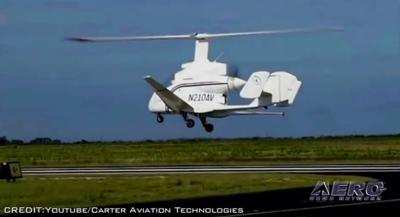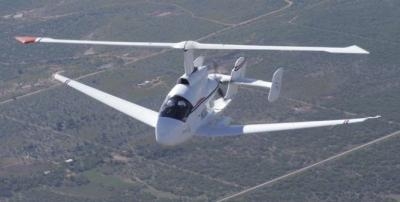Tue, Sep 15, 2015
Presentation Made At European Rotorcraft Forum In Europe
Carter Aviation Technologies last week made a presentation to the European Rotorcraft Forum in Munich Germany.

The European Union has been working on a program called Clean Sky for several years. This program seeks to improve environmental aspects of air transportation with reductions in CO2 emissions and noise pollution among the objectives. Recently, Clean Sky 2 was initiated with a consortium of participates, a multi-year plan, and a budget of around €4 billion between the European Union and industrial partners. Some of the loftier goals are a 20%-30% reduction in CO2 emissions and noise pollution with a 2014 technology baseline.
“I think we surprised a lot of folks in Munich. They’re workin a multi-year plan to create more environmentally-friendly aircraft and here we sit at Carter with a technology that achieves a reduction in CO2 between 66% [hovering aircraft] and 80% [jump takeoff aircraft],” expounded Jay Carter. “Our presentation created quite the buzz and we expect to be expanding our list of parties interested in learning more about our technology.” Carter’s Personal Air Vehicle or PAV pictured above has achieved an L/D of 11 and the potential to design an aircraft for an L/D of 16 is possible. The reduction in rotor drag achieved with the dramatic slowing of the rotor from a nominal takeoff maximum of 400 rpm to a cruise flight rotation of 100 rpm enables this level of cruise efficiency.

The idea of slowing the rotor down in flight is not new. In the 1930’s, aerodynamicists looking to improve upon autogyro efficiency recognized that if the rotor could be slowed down and kept stable, fantastic rotorcraft performance could be achieved in cruise. In the late ‘50s and early ‘60s, both the US and British governments spent years and millions of dollars trying to significantly slow the rotor. They had some success, but because
of noise, vibration, stability, and control issues, it was concluded to be either impossible or impractical. “We have been working the slowed rotor program for 21 years. It took 11 years before we first achieved an advance ratio of one. We had to identify and solve 10 issues to safely slow the rotor – the subject of 22 patents and 6 pending,” stated Jay Carter. The Carter presentation in Munich discussed those issues and the performance results from flight testing that have exceeded the emission and noise goals of Clean Sky 2.
(Images from file)
More News
Pilot Also Reported That Due To A Fuel Leak, The Auxiliary Fuel Tanks Were Not Used On June 4, 2025, at 13:41 eastern daylight time, a Piper PA-23, N2109P, was substantially damage>[...]
Have A Story That NEEDS To Be Featured On Aero-News? Here’s How To Submit A Story To Our Team Some of the greatest new stories ANN has ever covered have been submitted by our>[...]
From 2023 (YouTube Edition): Reflections on War’s Collective Lessons and Cyclical Nature The exigencies of war ought be colorblind. Inane social-constructs the likes of racis>[...]
Aero Linx: Colorado Pilots Association (CPA) Colorado Pilots Association was incorporated as a Colorado Nonprofit Corporation in 1972. It is a statewide organization with over 700 >[...]
High Speed Taxiway A long radius taxiway designed and provided with lighting or marking to define the path of aircraft, traveling at high speed (up to 60 knots), from the runway ce>[...]
 NTSB Prelim: Piper PA-23
NTSB Prelim: Piper PA-23 ANN FAQ: Submit a News Story!
ANN FAQ: Submit a News Story! Classic Aero-TV: One Mans Vietnam
Classic Aero-TV: One Mans Vietnam ANN's Daily Aero-Linx (07.03.25)
ANN's Daily Aero-Linx (07.03.25) ANN's Daily Aero-Term (07.03.25): High Speed Taxiway
ANN's Daily Aero-Term (07.03.25): High Speed Taxiway




